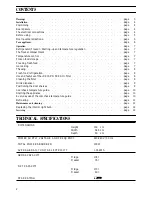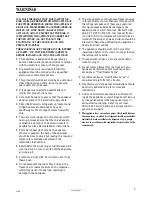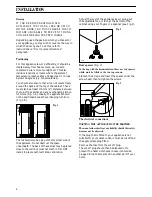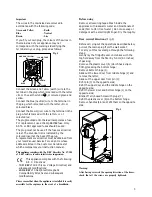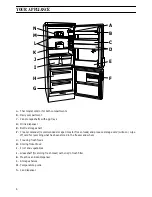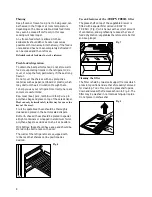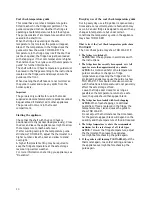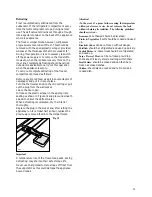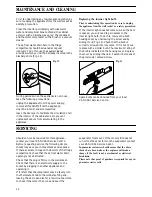
11
Defrosting
Frost is automatically eliminated from the
evaporator of the refrigerator compartment every
time the motor compressor stops, during normal
use. The defrost water drains out through a trough
into a special container on the back of the appliance
where it evaporates.
The freezer compartment, however, will become
progressively covered with frost. This should be
removed with the special plastic scraper provided,
whenever the thickness of the frost exceeds 1/4”.
During this operation it is not necessary to switch
off the power supply or to remove the foodstuffs.
However, when the ice becomes very thick on the
inner liner, complete defrosting should be carried
out and it is advisable to carry out this operation
when the appliance is empty.
To carry out complete defrosting of the freezer
compartment proceed as follows:
Remove any stored food, wrap it in several layers of
newspaper and put it in a cool place.
Turn the thermostat knob on the «
O
» setting or pull
out the plug from the wall socket.
Leave the door open.
Introduce the plastic scraper in the appropriate
seating as shown in Figure 12 and place underneath
a basin to collect the defrost water.
When defrosting is completed, dry the interior
thoroughly.
Replace the plug in the socket and, after letting the
appliance run for at least half an hour, replace the
previously removed food into the compartment.
Fig. 12
Important
A temperature rise of the frozen food packs, during
defrosting, may shorten their safe storage life.
Never use sharp metal tools to scrape off frost from
the evaporator as this could damage the appliance
beyond repair.
D068
Attention!
«In the event of a power failure causing the temperature
within your freezer to rise, do not re-freeze the food
without checking its condition. The following guidelines
should assist you.»
Ice-cream:
once thawed should be discarded.
Fruits & Vegetables:
if soft should be cooked and used
up.
Breads & Cakes:
can be re-frozen without danger.
Shellfish:
should be refrigerated and used up quickly.
Cooked Dishes:
i.e. casseroles should be refrigerated
and used up.
Large Pieces of Meat:
can be re-frozen providing
there are still ice crystals remaining within them.
Small Joints:
should be cooked and can then be re-
frozen as cooked dishes.
Chicken:
should also be cooked and re-frozen as a
cooked dish.


